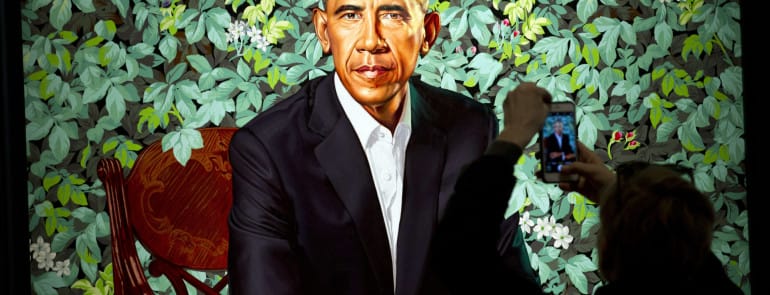In a world steeped in the grandeur of politics and power, celebrated artist Kehinde Wiley has once again taken the art scene by storm with his remarkable exhibition, “Maze of Power,” hosted at the prestigious Musée du Quai Branly – Jacques Chirac- in Paris. Wiley’s canvases are more than just portraits; they are windows into the intricate dynamics between African presidents and Western political structures – a reflection of modern African civilization.

Wiley’s astonishing collection of 11 portraits of African heads of state explores the essence of leadership in a continent often overshadowed by Western cultural hegemony. “This is not a celebration of individual leadership,” Wiley emphatically declares, challenging viewers to see beyond the veneer of authority. Each portrait, a breath-taking masterpiece, captures the essence of African leadership in a visually captivating manner. From the vibrant traditional attire of President Nana Akufo-Addo of Ghana to the stately presence of President Macky Sall of Senegal against a rocky shore reminiscent of the biblical Moses story, Wiley’s artistry shines a spotlight on the influences of Western colonies on African political structures.

What sets Wiley apart is his unique approach to engaging with his presidential subjects. Instead of delving into political discussions, he unveils a “vocabulary of power” by sharing aristocratic, royal and military portraits from the 17th to 19th centuries. In doing so, he allows these leaders to choose their own backgrounds and contexts, offering a profound commentary on the intersection of identity, representation and cultural heritage.
Born in Los Angeles, Kehinde Wiley is a globe-trotting artist, working across New York, Dakar and Lagos. His art transcends mere aesthetics, delving deep into the heart of contemporary Africa. His subjects, adopting heroic poses reminiscent of European and American portraiture, mirror the diverse backgrounds of the African leaders they represent.

“Maze of Power” invites viewers to navigate the labyrinthine intricacies of Western hierarchies and their influence on modern Africa. The exhibition, a mesmerizing blend of colours and patterns, compels us to reflect on the pervasive impact of Western structures on African civilization.
The seeds of this captivating project were sown in 2008 when Barack Obama embarked on his historic journey to the White House. Wiley’s vision of portraying a black president became a reality in 2018 with Obama’s portrait, catapulting him to global fame. However, the current exhibition is not an official commission, instead, Wiley retains complete artistic control, revealing the leaders’ portraits simultaneously with the public.

Wiley’s hyper-realistic portraits, bursting with vibrant colours and ornate floral patterns, grant his subjects an undeniable air of authority. Whether draped in Western-style suits or traditional attire, each leader is depicted according to the codes of Western depictions of power from centuries past.
Yet, Wiley adds a twist to these traditional portrayals by introducing occasional anachronistic elements. Swords, spyglasses and atlases find their place in these modern portraits, blurring the lines between homage and satire. Wiley’s exploration of “ambiguity” and “imbroglio” challenges us to see these leaders from multiple perspectives within the maze of understanding.

As Wiley himself puts it, “I don’t want to create politically correct art. What I want to create is something that might be a bit dangerous, a bit uncomfortable.” His work invites us to embark on a journey through a vividly colourful, pop-kitsch reinterpretation of Western artworks, provoking thought and reflection with each stroke of his brush.
While the choice of leaders was facilitated by Wiley’s celebrity status, he emphasizes that this project is not about rewarding behaviours. Each leader, with their unique personality, cultural heritage and relationship with their image, has the opportunity to express their will within Wiley’s framework.

For those with the means, owning a Wiley portrait comes at a substantial cost. Wiley’s art has reached astronomical prices at auctions, making it a collector’s dream. However, for the rest of us, there is a treasure trove of Wiley-inspired merchandise available on his website, from basketballs to tote bags, all bearing the indelible mark of this extraordinary artist.
Kehinde Wiley’s “Maze of Power” exhibition offers a glimpse into the complex world of African leadership, where art transcends politics and ambiguity dances with authority. It is a testament to the enduring influence of Western structures on contemporary Africa, a vibrant narrative spun through Wiley’s brushstrokes.

